
Agustín Cosme Damián de Iturbide y Arámburu, commonly known as Agustín de Iturbide and later by his regnal name Agustín I, was the first Emperor of Mexico from 1822 until his abdication in 1823. An officer in the royal Spanish army, during the Mexican War of Independence he initially fought insurgent forces rebelling against the Spanish crown before changing sides in 1820 and leading a coalition of former royalists and long-time insurgents under his Plan of Iguala. The combined forces under Iturbide brought about Mexican independence in September 1821. After securing the secession of Mexico from Spain, Iturbide was proclaimed president of the Regency in 1821; a year later, he was proclaimed Emperor, reigning from 19 May 1822 to 19 March 1823, when he abdicated. In May 1823 he went into exile in Europe. When he returned to Mexico in July 1824, he was arrested and executed.

Guadalupe Victoria, born José Miguel Ramón Adaucto Fernández y Félix, was a Mexican general and politician who fought for independence against the Spanish Empire in the Mexican War of Independence and after the adoption of the Constitution of 1824, was elected as the first president of the United Mexican States. He was a deputy in the Mexican Chamber of Deputies for Durango and a member of the Supreme Executive Power following the downfall of the First Mexican Empire, which was followed by the 1824 Constitution and his presidency. He later served as Governor of Puebla.

The Mexican Empire was a constitutional monarchy and the first independent government of Mexico. It was also the only former viceroyalty of the Spanish Empire to establish a monarchy after gaining independence. The empire existed from 1821 to 1823, making it one of the few modern-era independent monarchies in the Americas. To distinguish it from the later Second Mexican Empire (1864–1867) under Emperor Maximilian, this historical period is commonly referred to as the First Mexican Empire. The empire was led by former Royal Spanish military officer Agustín de Iturbide, who ruled as Agustín I.

Juan José Ruiz de Apodaca y Eliza, 1st Count of Venadito, OIC, OSH, KOC was a Spanish Navy officer, nobleman and colonial administrator who served as the viceroy of New Spain from 20 September 1816 to 5 July 1821 during the Mexican War of Independence.

The Mexican War of Independence was an armed conflict and political process resulting in Mexico's independence from the Spanish Empire. It was not a single, coherent event, but local and regional struggles that occurred within the same period, and can be considered a revolutionary civil war. It culminated with the drafting of the Declaration of Independence of the Mexican Empire in Mexico City on September 28, 1821, following the collapse of royal government and the military triumph of forces for independence.

The Treaty of Córdoba established Mexican independence from Spain at the conclusion of the Mexican War of Independence. It was signed on August 24, 1821 in Córdoba, Veracruz, Mexico. The signatories were the head of the Army of the Three Guarantees, Agustín de Iturbide, and, acting on behalf of the Spanish government, Jefe Político Superior Juan O'Donojú. The treaty has 17 articles, which developed the proposals of the Plan of Iguala. The Treaty is the first document in which Spanish and Mexican officials accept the liberty of what will become the First Mexican Empire, but it is not today recognized as the foundational moment, since these ideas are often attributed to the Grito de Dolores. The treaty was rejected by the Spanish government, publishing this determination in Madrid on February 13 and 14, 1822.

Iguala, known officially as Iguala de la Independencia, is a historic city located 102 km (63 mi) from the state capital of Chilpancingo, in the Mexican state of Guerrero in southwestern Mexico.

Andrés Eligio Quintana Roo was a Mexican liberal politician, lawyer, and author. He was the husband of fellow independence activist Leona Vicario.

At the end of the Mexican War of Independence, the Army of the Three Guarantees was the name given to the army after the unification of the Spanish troops led by Agustín de Iturbide and the Mexican insurgent troops of Vicente Guerrero, consolidating Mexico's independence from Spain. The decree creating this army appeared in the Plan de Iguala, which stated the three guarantees which it was meant to defend were religion, independence and unity. Mexico was to be a Catholic empire, independent from Spain, and united against its enemies.
In Mexican history, a plan was a declaration of principles announced in conjunction with a rebellion, usually armed, against the central government of the country. Mexican plans were often more formal than the pronunciamientos that were their equivalent elsewhere in Spanish America and Spain. Some were as detailed as the United States Declaration of Independence. Some plans simply announced that the current government was null and void and that the signer of the plan was the new president.
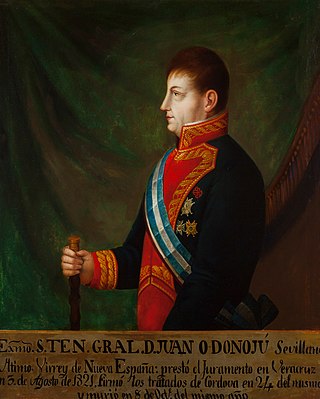
Juan José Rafael Teodomiro de O'Donojú y O'Ryan was a Spanish-Irish military officer, diplomat and Viceroy of New Spain (Mexico) from 21 July 1821 to 28 September 1821 during the Mexican War of Independence. He was the last Viceroy of New Spain.
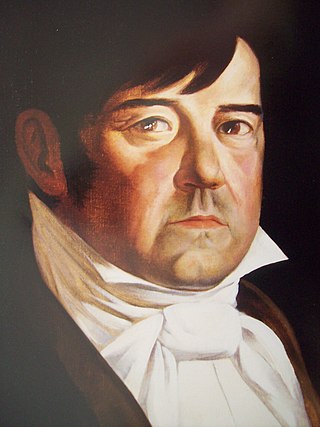
Don Miguel Ramos Arizpe was a Mexican priest and politician, and known as "the father of Mexican federalism."

The Declaration of Independence of the Mexican Empire is the document by which the Mexican Empire declared independence from the Spanish Empire. This founding document of the Mexican nation was drafted in the National Palace in Mexico City on September 28, 1821, by Juan José Espinosa de los Monteros, secretary of the Provisional Governmental Board.

Spanish attempts to reconquer Mexico were efforts by the Spanish government to regain possession of its former colony of New Spain, resulting in episodes of war comprised in clashes between the newly born Mexican nation and Spain. The designation mainly covers two periods: the first attempts occurred from 1821 to 1825 and involved the defense of Mexico's territorial waters, while the second period had two stages, including the Mexican expansion plan to take the Spanish-held island of Cuba between 1826 and 1828 and the 1829 expedition of Spanish General Isidro Barradas, which landed on Mexican soil with the object of reconquering Mexican territory. Although the Spanish never regained control of the country, they damaged the fledgling Mexican economy.
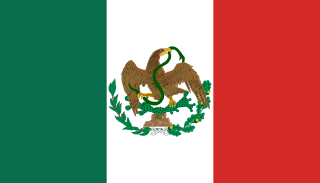
The Supreme Executive Power was the provisional government of Mexico that governed between the fall of the First Mexican Empire in April 1823 and the election of the first Mexican president, Guadalupe Victoria, in October 1824. After Emperor Iturbide abdicated, the sovereignty of the nation passed over to Congress, which appointed a triumvirate, made up of Guadalupe Victoria, Pedro Celestino Negrete, and Nicolas Bravo, to serve as the executive, while a new constitution was being written.

The Battle of Azcapotzalco,, was fought on August 19, 1821, in the town of Azcapotzalco, near Mexico City. It was to be one of the last military action of the Mexican War of Independence. The insurgents, commanded by the colonels Anastasio Bustamante and Luis Quintanar, fought the Spanish forces commanded by Manuel de la Concha.
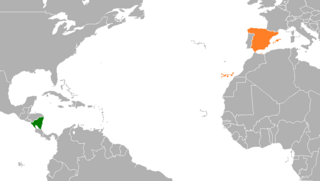
Nicaragua–Spain relations are the diplomatic relations between Nicaragua and Spain. Both nations are members of the Association of Academies of the Spanish Language and the Organization of Ibero-American States.

The Regency of the Mexican Empire was a period of transition in the history of the Mexican monarchy in the absence of the Emperor of Mexico and presided by a president of the same during the First Mexican Empire (1821–1823) and the Second Mexican Empire (1863–1867). The regency is the government of a State during the minor age, absence or incapacity of its legitimate prince.
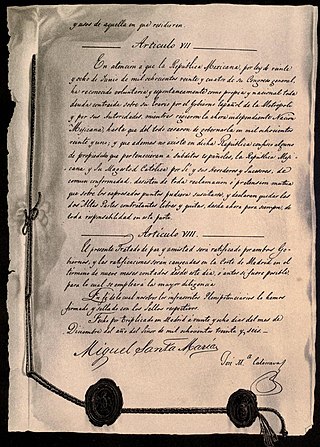
The Santa María–Calatrava Treaty was a treaty between Mexico and Spain recognizing the independence of Mexico on December 28, 1836. It ended the tensions between both nations that emerged from the Mexican War of Independence, which began in 1810. It was signed by the Mexican representative Miguel Santa María and José María Calatrava, representing Spain.
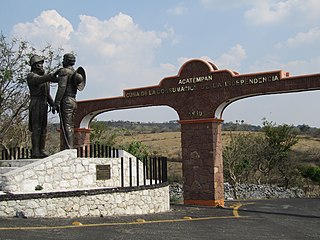
The embrace of Acatempan refers to an event in Mexican history in which Agustín de Iturbide, commander-in-chief of the military of southern New Spain, and Vicente Guerrero, leader of the forces fighting for Mexican Independence, participated. This event took place on February 10, 1821. Tradition has it that this event marked the reconciliation between the viceregal forces and the insurgent army.



















